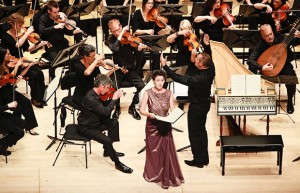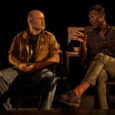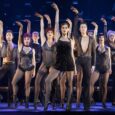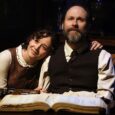Outside it was a grey, hostile, traffic snarled, drizzly Sydney evening but here in the City Recital Centre it was warm, golden and all at peace. I felt all my angst, peak hour jitters and parking station traumas drop away like moldy prison fatigues as this glorious, swelling music radiated through me – radiated more like light than just sound, warming and glowing.
The Australian Brandenburg Orchestra had chosen to open their 2014 Season – their 25th! – with the Bach Magnificat. Bolstered by the Brandenburg Choir and select guest soloists, this truly grand piece of music was a sharp choice for a number of reasons.
Firstly, the Magnificat is Bach, the composer who gives the Orchestra its name and much of its inspiration. Like all of Bach, it satisfies on many levels – intellectual, artistic and, most importantly, emotive. Written in 1723 to impress Bach’s new employers, the Liepzig Town Council, the Magnificat is 12 short movements (with an additional four linking movements) that utilise a stunning variety of orchestral and voice combinations.
Leader Paul Dyer chose a rarely performed revised version of the work for tonight – as ever, going for authenticity and period veracity.
All of this combined to make the Magnificat the perfect vehicle for The Brandenburg, one that showed the Orchestra’s (and Choir’s) formidable strengths in the brightest possible light. In short, there couldn’t have been a better choice to open The Brandenburg’s 25th anniversary celebrations.
Paul Dyer, as ever, drew sparkling and full-blooded performances from the Orchestra, his expansive and quite obvious joy in the music inspiring both players and audience. The heightened mood drew exceptional performances from all, especially soprano Jane Sheldon, soaring both in intimate settings and over the full force of the Orchestra and Choir.
Counter-tenor Maximilian Riebl also impressed – his remarkable voice was entirely transporting, whether in duet with tenor Richard Butler or in solo. Against the more human-scale period sound of the Brandenburg, Riebl’s voice was other-worldly, haloed with a luminous quality.
The Orchestra returned after interval, minus Choir, with another Bach: the Orchestral Suite No.4 in D major. This showed the lighter nature of The Brandenburg’s sound, one that in contrast to modern, more super-charged ensembles, is a true delight. The instruments speak in a more human tongue, their Baroque period voices and timbres a gentler call from across the ages. The passages for woodwinds (flute, recorder, oboe, bassoon) and period brass filled the Hall with the woody air of a long-gone European court dance.
To mark this landmark year, The Brandenburg commissioned international composer Elena Kats-Chernin to write a unique work for them. Kats-Chernin is a garlanded composer of renown, having written for the Sydney Olympics Opening Ceremony as well as a wide and prolific range of international commissions.
Her piece for The Brandenburg, the wittily titled Prelude and Cube, yanked the audience, orchestra (and choir) into the 21st century. Using the Bach Magnificat as a ‘trigger’ for her work, Kats-Chernin overlaid combinations of instruments and styles in a fast-moving, dazzling and challenging thrill-ride. Over the work’s two movements, all aspects of the players and vocalists were touched upon in an array of combinations: traditional, modern-adaptation and strikingly original.
With the almost electric voice of Christina Leonard’s soprano saxophone flying high over it all, and touches of jazz (and even blues) rising out of the music, Prelude and Cube played to the great strengths of The Brandenburg in a way almost too big for the Hall. I might have enjoyed it even more if her writing had played to their humbler side as well.
Prelude and Cube was the perfect mirror image and foil to the Bach Magificat – though divided by almost three centuries they are both sides of the same shimmering coin, both expansive, inventive and joyous pieces.
Expansive. Inventive. Joyous. These words describe The Australian Brandenburg Orchestra under Paul Dyer perfectly. To think that Dyer’s passion has kept the Orchestra moving from strength to strength over 25 years is an inspiration for all of us – not only for any of us in the Arts but to all of us in our daily lives.
And that is something worth celebrating.






